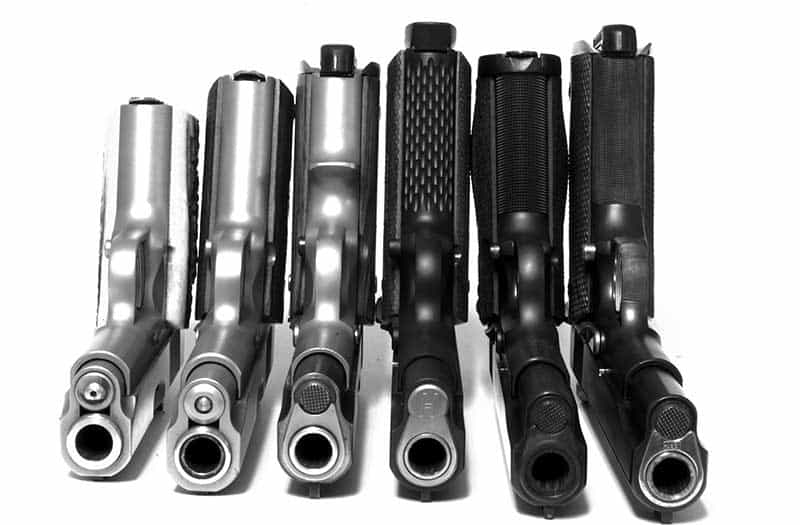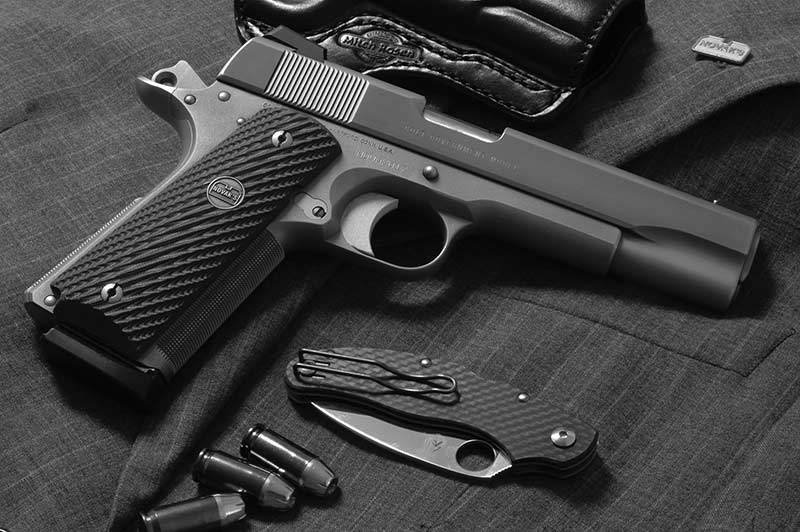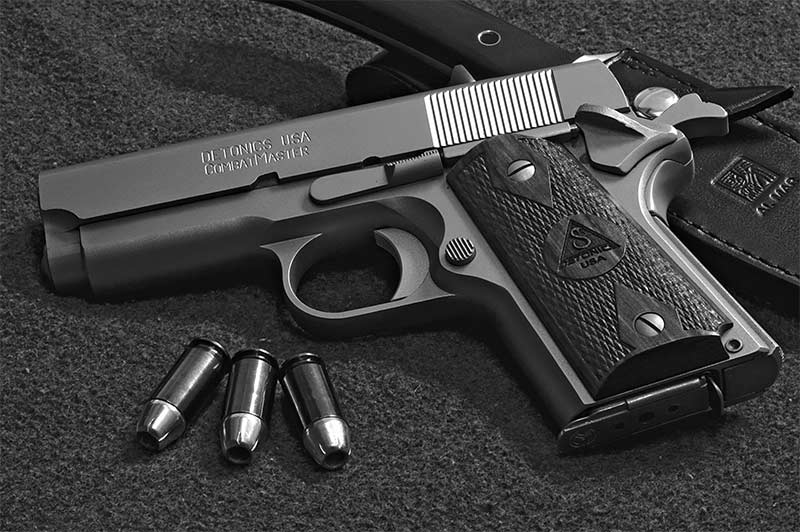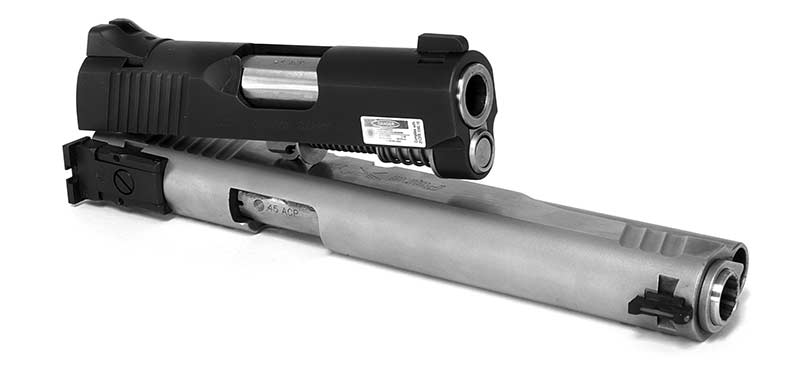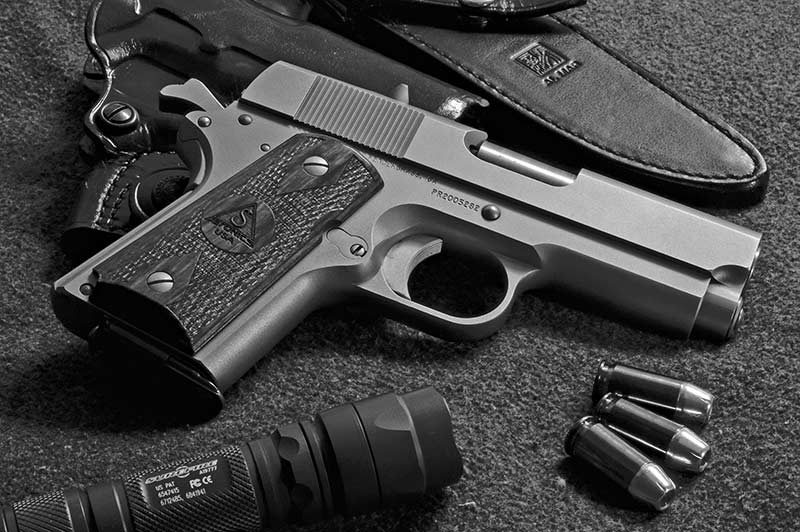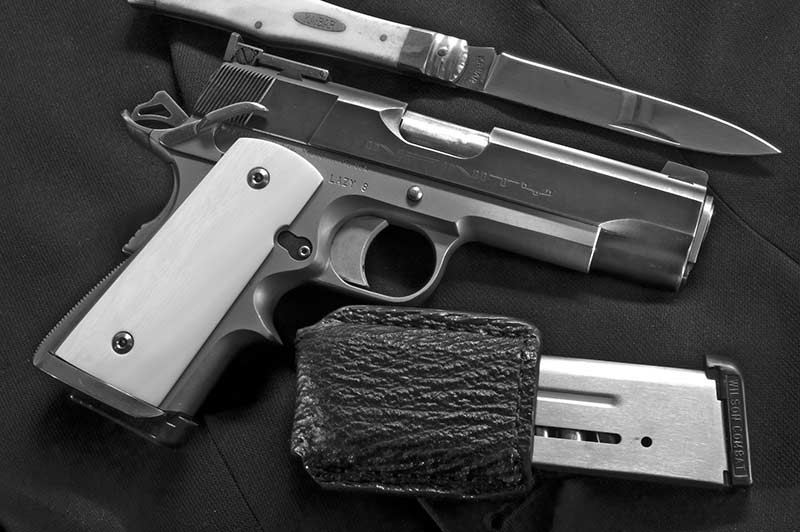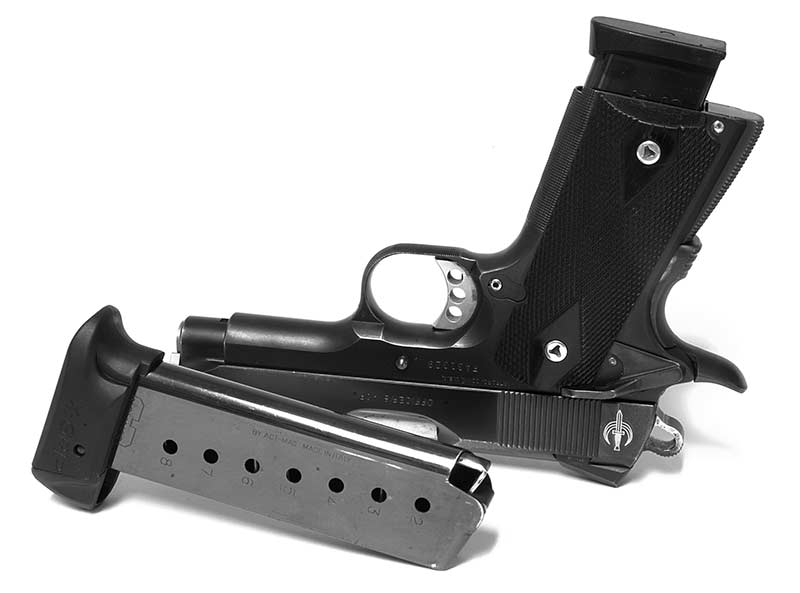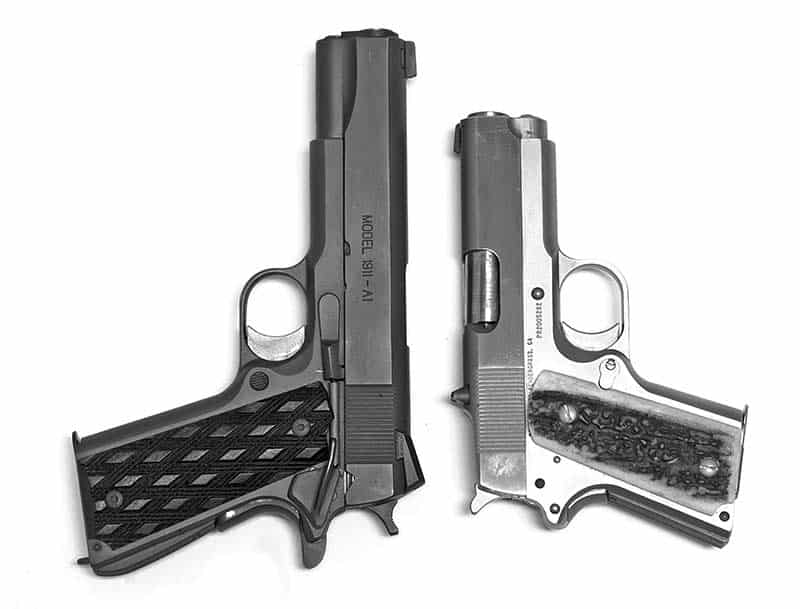Big Ones Short Ones Tall Ones
Which Size 1911 Is Best For You?
Whether you’re a seasoned shooter or a beginner picking your first pistol for self defense, it doesn’t take long to realize the 1911 is still the king of the hill. After nearly a century of continuous use by military, law enforcement, and armed civilians alike, the 1911 still fills more pages in gun magazines — and more shelves in gun stores — than any other model, or in some cases, than all others combined. Unfortunately, if you’ve chosen to buy one as your carry gun, the decision making process has only just begun. At last count, I’ve worked with 1911s from 13 different manufacturers, in nine different sizes, and chambered for ten different calibers, ranging from .22 LR to .50 GI. Some days, even I get confused.
But before we get too far into what’s out there, let me first say the 1911 is still something of a professional’s pistol, and isn’t necessarily the best choice for everyone. They can be finicky, may bite the hand that feeds them, and they do not reward careless gun handling, so if you want to carry one, it’s best to learn how to use it and stay in practice — which is what you should do no matter what you carry. In well-trained hands, though, the 1911 .45 can be devastatingly effective, and is an excellent choice for a fight stopping concealed carry pistol.
What Size?
Since most people choose a carry gun by what they can conceal, the first choice you have to make is what size pistol you need. Since there are six common barrel lengths (and at least three different grip lengths) this may be harder than you think.
In the beginning, there was the Government Model .45, which has a 5″ barrel. This is the classic 1911, as designed by John Browning, adopted by the US Military, and currently carried by FBI SWAT. It’s the most reliable of the 1911s and
probably the easiest to shoot well, but it’s a full-sized gun in every sense of the word. Although I — and many other people — carry one on a daily basis, at 8 1/2″ in overall length and two pounds in weight, most CCW holders will find it difficult to conceal without building their wardrobe around it.
To make the big .45 easier to carry, in the 1940s, Colt introduced their Commander, which has a 4 1/4″ barrel. In the series of compromises required to make a big gun small, many consider this the best size. Lopping 3/4″ off of the slide made for less gun to hide, but unfortunately, the butt of a pistol is the hard part to conceal, and the Commander did nothing to address that.
In the meantime, General Curtis LeMay, of SAC fame, came up with the idea of cutting 1/2″ off the butt of the Commander to create a compact .45 his pilots could carry inside the cramped confines of a cockpit. Although his design was ultimately produced by the short-lived Randall company, he had first shown it to Colt, and in 1985, they introduced the Officer’s ACP, which featured the 1/2″ shorter butt of LeMay’s design mated to a short slide with a stubby barrel that measured 3 1/2″ — 1 1/2″ shorter than a Government Model. The Officer’s ACP not the first of the mini-1911’s: it was prefigured by the iconic Detonics CombatMaster, which also had a 3 1/2″ barrel. Introduced in 1977 and best known for its role in the original Miami Vice, the CombatMaster combined the short barrel with a butt nearly a 1/2″ shorter than an Officer’s ACP, and nearly a full inch shorter than the Government Model. So short, in fact, the grip safety had to be left off. Similarly, Kimber’s Ultra, while it has an Officer’s ACP-size butt, has a diminutive 3″ barrel, which puts it in the same general size class as the CombatMaster, which is to say, not far off from a Walther PPK.
Options A Plenty
So with the history lesson out of the way, the two big factors in the size of a 1911 are the length of the slide, and the height of the frame. Since the CombatMaster is the only pistol offering an 1″-shorter butt, the rest of the market options are limited to two frame sizes: large (Governmentsized), or small (Officer’s ACP). The slide/barrel sizes, however, come in three: small (ranging from 3 to 3 1/2″), medium (from 4 to 4 1/2″), and large (5″). Although there are factory 6″ pistols (and AMT’s Hardballer actually stretched to 7″), anything over 5″ is unwieldy as a weapon, and a poor choice for concealed carry.
Most people find their answer in either a Commander-sized pistol (large frame, medium barrel/slide), or some combination of a small frame and a medium or small barrel/slide. My personal preference among the compacts is what Colt released as the Concealed Carry Officer’s, or C.C.O., or Les Baers Stinger which combines the short butt of the Officer’s ACP with the medium-length slide of the Commander. It carries like a little gun, but shoots like a big one.
While the smaller pistol s definitely have a coolness factor to them, the small size does come with a cost. The first of the drawbacks — although not the most serious — is shootability. With a short grip most people can’t get their whole hand on, and a short sight radius making precise sight alignment more difficult, Officer’s-size pistols are notoriously hard to shoot well. Add in the vicious recoil that comes standard on the lightweight aluminum-framed guns, and you’ve got a really good recipe for a gun many shooters simply can’t hit with under the best of conditions, much less under stress. This is not to say, however, they’re inaccurate. I carried a steel-frame Officer’s ACP for several years, and could keep all of my rounds on a silhouette target at 100 yards. What this means is, the smaller the gun, the more practice it takes to master.
It’s Gotta Run
The more serious factor you may not be able to improve, however, is the reliability. Because short slides affect the angle at which the barrel locks and unlocks, the type and power of the recoil spring, and the inertia that’s holding the action shut when the pistol fires, little guns can be extremely finicky. And the shorter they are, the more finicky they become. Even when they’re set up properly, the fast speeds at which the slide cycles means that worn magazine springs may not pop up a new round in time for the slide to pick it up. Little guns also tend to eat recoil springs, so it’s a good idea to get on a regular schedule of replacing those and the mag springs before the gun starts to fail.
Let me be clear, even with regular preventive maintenance, some little guns may never function reliably, even after extensive gunsmithing. Others, like my Detonics CombatMaster, may go thousands of rounds without a bobble. The only way to know for sure which category yours fits in is to shoot it. Many people recommend firing 200 rounds of your carry ammo through a pistol before you trust it, and that’s a good benchmark. My own standard test usually consists of 500 rounds, often of mixed jacketed hollowpoint, without cleaning or oiling; my carry pistols often have over 2,000 rounds through them. Yes, that’s extreme — but I know they work. And once you know yours works, practice regularly with it so you stay on top of any developing problems.
Less BBs
Keep in mind also that the shorter grip frame means you have a shorter magazine, and therefore fewer bullets — usually six or seven rounds of .45 ACP, as opposed to the eight we expect in a Government Model magazine. Because of this, many people carry full-size magazines for their reload. There are two problems with this, but both are easily remedied.
The first is Government-size mags may not have sufficient spring pressure to keep up with the faster-cycling slide of the short gun. Solution? Test yours to make sure they work, then keep fresh springs in them. The second problem is over-insertion. Unless the mag has some kind of a stop on it, if your pistol is at slide lock and you slam in a full-size mag, the odds are good that you’ll drive it up the magwell, past the mag catch, and into the path of the slide. It will stay there until you strip it out, and it will keep the slide from traveling forward, locking down the gun.
Since really short guns were their specialty, Detonics USA solved this problem by creating a special ejector that limited magazine insertion. On other pistols, you have to modify the magazine in some way. Wilson 8-round mags are available with a stop in place on the mag body. Wilson also offers an upward-extending floorplate that lets you retrofit existing Government-sized mags. Freed Designs offers a product called the X-Grip that similarly fits over the existing floorplate of Novak and Mec-Gar style magazines, and has the added benefit of being molded in the shape of the gun’s grip, effectively giving you more to hang on to as well.
While we’re on the topic of more to hang on to, it’s time to talk about add-on magazine funnels. While most dismiss funnels as something of a gimmick (and they really aren’t a necessity), they make it much easier to hit your magwell when you’re doing a fast reload. Unfortunately, the most common ones, such as the ubiquitous Smith & Alexander, add about a quarter inch to the bottom of the gun, making it both longer and more butt-heavy. On a Government Model, this makes the gun harder to hide and, for some, more difficult to handle. On the shorter Officer’s sized frame, however, the extra 1/4″ gives you more to hang on to, in effect giving you a mid-size grip halfway between the big and small frames. ‘Tis a consummation devoutly to be wished. The gun is still readily concealable, but the added weight helps tame recoil, the added length gives you a better grip, and the huge funnel makes it faster to reload. All in all, not a bad trade-off, and one I’ve made on my personal Officer’s .45.
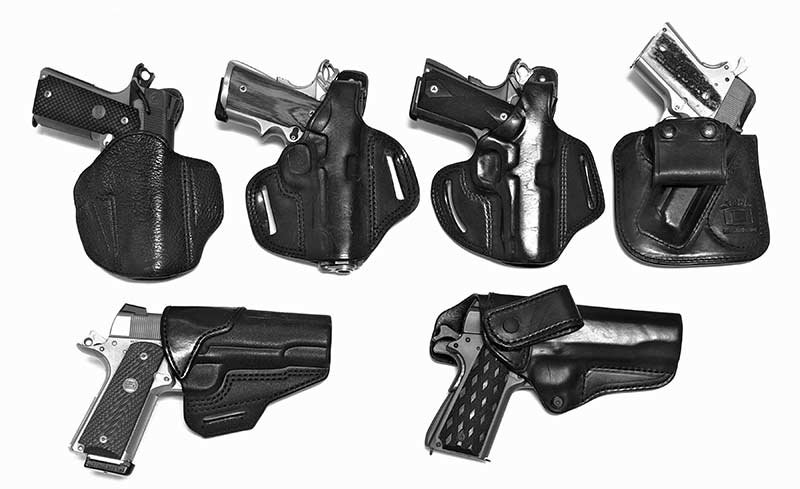
Some of the 1911 .45s I’ve carried through the years: (clockwise from upper
left) titanium-framed Caspian Commander, Caspian fingergroove Officer’s/
Commander hybrid, Colt Officer’s ACP, Detonics CombatMaster, Springfield
Government Model, and a Novak Colt Government Model. Oddly enough, I
started with the little guns, and they’ve been getting progressively bigger.
Decisions
Selecting a carry gun is a uniquely personal decision: it must work, it must be able to stop a fight, and you must be able to use it and be willing to carry it. Beyond this, most decisions are matters of personal preference, and the size pistol you need will be determined by things like your physique, the way you dress, and where you live. No matter how carefully you select a 1911, though, don’t be surprised if your first .45 turns out not to be exactly what you needed. Your needs will evolve over time, and some things only reveal themselves after you’ve carried — and shot — a gun for some time. Don’t be afraid to trade it in and try another model, or to have it worked over by a gunsmith once you know what you need. Handle and shoot everything you can, but some things you’ll only learn by experience.
No serious 1911 aficionado ever finds the “ultimate” 1911, it’s like grasping oil in your hand. But finding one that’s well-suited for your defensive needs is a much easier job, and the market has never been as full of options as it is now.
For more info:
SPRINGFIELD ARMORY
www.springfield-armory.com
888-680-6866
KIMBER
www.kimberamerica.com
800-880-2418

Get More Personal Defense Tips!
Sign up for the Personal Defense newsletter here:

